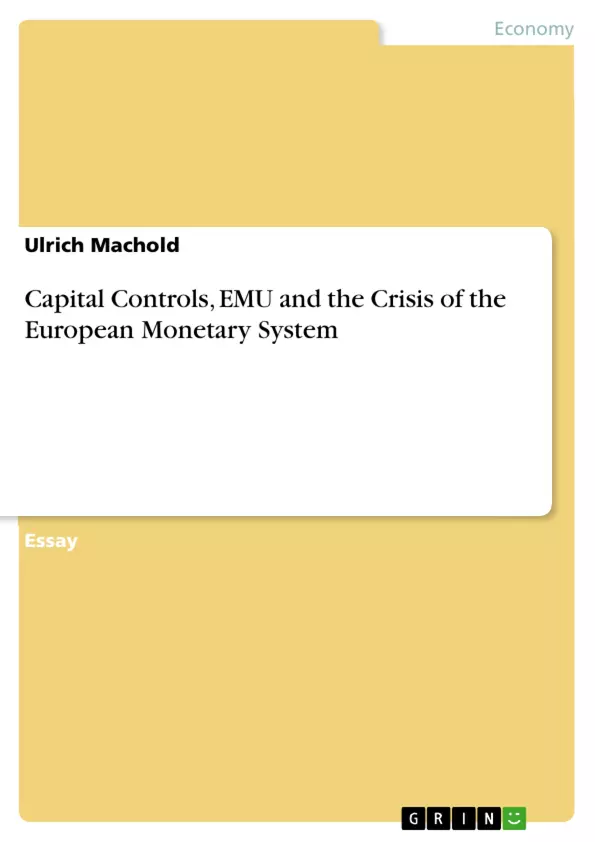For European monetary affairs, 1992 was a watershed: In January, the European Monetary System (EMS) celebrated five years of stability; by November, it was all but falling apart. Two of its members had been driven from the system, two others had experienced steep and involuntary devaluations. The EMS was undergoing the worst crisis of its existence.
When analysing these events, they inevitably lead to the issue of financial liberalisation. If the argument that the lack of control over international capital flows is at the heart of such crises is true, their costs must be weighed against the benefits of the liberalisation process.
But can the use of capital controls be in any way compatible with the process of European financial integration? Does the idea not go against the entire philosophy embodied in the project of economic and monetary union (EMU)? Some authors argue that not only can capital controls be made compatible with the integration process but that they are in fact the only option available to safeguard any pegged exchange rate system against the excesses of occasionally irrational and overwhelmingly powerful financial markets.
The resulting question, though merely speculative in retrospect, is thus two-fold: Could capital controls have helped to prevent the 1992-crisis of the EMS and would it therefore have been beneficial to allow for this instrument afterwards, instead of widening the fluctuation bands to 30 per cent? And, resultingly, could capital controls exist within a fixed exchange rate system like the EMS then and the EMSII in the future?
I shall, as preliminaries, first briefly summarise the main arguments of the discussion on the desirability of capital controls. Subsequently, I shall discuss, whether capital controls can actually achieve what they were designed for. In the main section, I shall analyse what causes for the 1992-crisis seem probable, why the post-1992 re-constitution of the system took the form it actually did and whether capital controls could have been relevant in this context or will do so in the future.
Inhaltsverzeichnis (Table of Contents)
- Introduction
- 1. What are capital controls?
- 1.1 Types of capital controls
- 1.1.1 Controls on capital outflows
- 1.1.2 Controls on capital inflows
- 1.2 Arguments for and against the imposition of capital controls
- 2. How effective are capital controls?
- 3. Capital controls and the crisis of the EMS
- 3.1 Conditions for the viability of a pegged exchange rate system
- 3.2 Causes of the crisis
- 3.2.1 Inevitable policy shifts
- 3.2.2 Multiple equilibria and self-fulfilling speculation
- 3.3 Implications
- 3.4 Solutions
- 3.5 The right choice?
- Conclusion
Zielsetzung und Themenschwerpunkte (Objectives and Key Themes)
This essay explores the role of capital controls in relation to the 1992 crisis of the European Monetary System (EMS) and the broader context of European financial integration. It examines the effectiveness of capital controls as a means of managing currency speculation and achieving monetary policy independence. The essay delves into the debate surrounding the desirability of capital controls within a fixed exchange rate system like the EMS, considering their potential to prevent crises and maintain stability.
- The nature and types of capital controls
- Arguments for and against the imposition of capital controls
- The effectiveness of capital controls in managing currency speculation
- The role of capital controls in the 1992 EMS crisis
- The compatibility of capital controls with European financial integration
Zusammenfassung der Kapitel (Chapter Summaries)
The first chapter introduces the concept of capital controls, outlining their definition and different types. It also examines the arguments both for and against their implementation.
Chapter two delves into the effectiveness of capital controls in achieving their intended purpose, particularly in managing currency speculation and mitigating financial crises.
Chapter three analyzes the causes of the 1992 crisis of the EMS, exploring the role of policy shifts, speculation, and multiple equilibria. It also examines the implications of the crisis and potential solutions, including the potential role of capital controls.
Schlüsselwörter (Keywords)
Capital controls, European Monetary System (EMS), currency speculation, financial liberalization, exchange rate systems, monetary policy independence, financial integration, economic and monetary union (EMU), 1992 EMS crisis.
- Quote paper
- Ulrich Machold (Author), 2002, Capital Controls, EMU and the Crisis of the European Monetary System, Munich, GRIN Verlag, https://www.grin.com/document/9448



